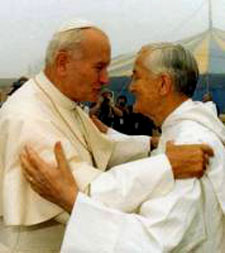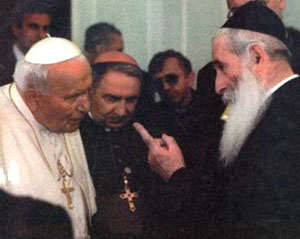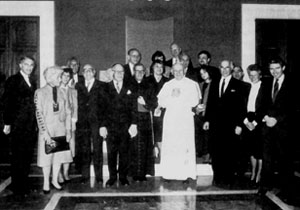 |
Book Reviews
Yes, Crisis in the Church!
Fr. Stephen Somerville
Book review of No Crisis in the Church?,
by Simon Galloway, Manchester: New Olive Press, 2006, 268 pp.
No Crisis in the Church is an arresting title. It is even more intriguing when you spot the Question Mark after it. Such is the name of Simon Galloway’s recent book, 2006, from New Olive Press.
Its subtitle is “A rigorous comparison of Catholic Church teachings before and after the Second Vatican Council (1962-65).” The bulk of the work is a stream of short quotations from the teaching sources, mostly Scripture and the Popes before Vatican II, placed on the left side of each page. On the right side are related quotations from the last five Pope and from the Vatican II documents, all tending contrary to the facing doctrine.
Are these in orderly fashion or only a jumble? They are in excellent order, divided into five main parts, A to E. They begin where the Catholic new ideas are most fundamental and disturbing. Part A is on Ecumenism, B on Religious Liberty, C on the New World Religion, and part D on the New World Order. The one remaining part is a wide miscellany, but all teaching on Faith and Morals.
The book greatly focuses our thinking by naming each subsection with a simple question. For example A-1 asks, Are Baptized Protestants and separated Greek Orthodox saved? A-2 asks, Are these same still in the mystical Body of Christ’s Church? A -10 asks, Can non-Catholics be given the Sacraments? In Section B on religious liberty, the first question: Is man free to follow whatever religion he chooses? B-4 asks, Should other religions be respected by Catholics? Part C treats of the World Religion, and C-1 asks, Is Man Divine? C-5 asks, Who is the Way, Christ or Man? Under Part D, on the new world order, it asks (D-2), Who reigns over the world: Christ the King or a World Authority?

JPII embraces Protestant Roger Schutz |
And so it goes, through these world-shaking questions: Ecumenism, Freedom, One World Government. Then comes part E, the miscellany, but always on matters of Faith and Morals. Part 6-E asks about teaching on the Resurrection. Part 4 treats of evolution; Part 3 on the teaching on the Fall of Man.
No Crisis in the Church does not make for peaceful continuous reading, but is more suited to quick topical consultations. The Author in his Preface declines to provide “glosses or comments.” Indeed, to do this adequately would require a small library of theology. It is to be presumed that the reader will have some basic manuals of theology.
Nevertheless, No Crisis does not leave us simply adrift after Section E and its different topics. There follow 40 pages of valuable appendices. How do they bolster the crisis theme?
The fact is that many practicing Catholics today, perhaps a large majority, would answer, “No, there is no great crisis in the Catholic Church. We should ignore the alarmist people. We have just witnessed the long and magnificent papacy of John Paul the Great. The Church is absorbing new ideas in a gradual and holy way, like lay participation in the liturgy, Mass in English, the shortened Eucharistic fast, friendliness with other religions, and so on. The sexual abuse is exaggerated, and most of our priests are good.”
So runs, I fear, the average Catholic opinion. Read also the Catholic press supported by the Bishops. It has little or no tone of alarm.
Then how do we explain the serious reversal in Catholic teaching and liturgy? Do we attribute everything to “societal change,” to a “peaceful secularization”? Those changes at Vatican II: Did they come from the floor, from the grassroots Bishops, from a healthy, Catholic theological conscience? Or were they imposed from the top by a revolutionary imposition of Pope-Bishops-Modernist theologians? Were not all these men trained in good and holy Catholic seminaries? Or had these seminaries been infiltrated by clever Freemasons and Jews in disguise, with orders to seek promotion and corrupt the Catholic Church from within by modern and beguiling ideas?
The evidence for the evil progressivist conspiracy has been available increasingly since Vatican II. Yet Catholics seem not to realize that their Church is being destroyed, that the Faith is being abandoned, that the grace of God is scarcely flowing. Books, magazines, and newspapers that recognize and discuss these evils are forbidden and suppressed in the regular diocesan bookstores and church pamphlet racks.
Author Simon Galloway tells (in his post-scriptum) how he returned to his Catholic Faith in 1998 after a long absence from the Church. He was dismayed and shocked by the religious degradation that he observed on all sides. He says: “I began studying books and articles by other (bewildered) Catholics. They all seemed to point to Vatican II as the source of this liberal updating .... I consulted papal teachings before and after this revolution .... What I discovered I wrote down in this book” (p. 268).
Returning now to the question: Were the Church and the seminaries infiltrated by disguised enemies? The answer is indeed Yes, and so adroit were the commandos that even today we scarcely hear in the Catholic press about this fiendishly successful operation. It is a project rooted in recent times and also in past centuries.

Chief rabbi Joskowicz demands removal of the last cross from Auschwitz |
Writer Galloway chooses several rather brief documents to support the allegations. Appendix I is “Jewish Freemasonry on the Subversion of the Catholic Church and State.” From secret Jewish meetings in Paris, statements were smuggled out and published in The London Catholic Gazette, February 1936, confirmed later in Paris, Le Reveil du Peuple. Behind it was B’nai B’rith, “the secret directors of international Freemasonry.” One line reads, “We have induced some of our children to join the Christian Body with the explicit intimation that they should work .... for the disintegration of the Christian Church, by creating scandals within her.” Shortly after, “We are the Fathers of all Revolutions .... We were the creators of the Protestant Reformation .... Martin Luther was our dupe ....” And so goes this candid tale of hate-filled conspiracy.
Appendix 2 is “Jewish Freemasonry on the Infiltration of the Church and the State.” It is the plan of the Jews to plot harm when they were about to be expelled from Spain, a Catholic Country, in 1492, when the Catholic monarch had learned of their intentions.
Appendix 3 is the stunning “The Permanent Instruction of the Alta Vendita Masonic Lodge .... Against the Catholic Church.” This brutally frank sermon to destroy the Catholic Church fell into the Church’s hands, and was published by order of Pope Pius IX (d. 1878) and Leo XIII (d. 1903). The authors (always “we”) are confident of winning some day – a Pope to their liking. That day came in 1958. Msgr. George Dillon published this document in 1950 with an imprimatur and nihil obstat.
Appendix 4 supplies about 80 quotes from leading Masons concerning the demise of the Catholic Church at the hands of Freemasons.

JPII receives the B'nai B'rith, March 23, 1984 |
Appendix 5 is “a list of alleged Masons in the Catholic Hierarchy,” that is, mostly Bishops. Dating from July 1976, it gives the Bishop, position, date of initiation, code number and code name. The Canon Law of 1918 had decreed the automatic excommunication of any Catholic joining the Masons. The new modern code omitted this penalty, suggesting that by now the Masons had indeed taken over the Catholic Church.
Appendix 6 is “The Full Version of the Prayer to St. Michael the Archangel,” composed by Pope Leo XIII after the horrifying dialogues that he, in a trance, heard near the tabernacle on October 13, 1884, between Jesus and Satan. Satan asked and received power and time (100 years) to destroy the Church. It seems that a much-watered-down version of the prayer was eventually imposed in 1934. Was this by friends of Satan and apostasy? The prayer (prayers for the conversion of Russia) was finally deleted after Vatican II, in another blow against the Church. Up till then, they were recited in English after every Low (not sung) Mass. The “full version” of the prayer is a powerful, dramatic, colorful appeal against the forces of evil. Would that the whole Church had prayed it daily since 1884, as Pope Leo XIII desired.
Appendix 7 is “The Oath against Modernism” given by Pope St. Pius X in 1910. It was to be sworn by all Catholic leaders, including pastors, on taking up their charge.
The seven appendices are valuable tools to prevent or arrest the takeover by Satan. The book No Crisis in the Church is to be commended for making them available in handy and detailed format.

Posted on January 25, 2007

Related Topics of Interest
 Gone With Wind in the Vatican Gone With Wind in the Vatican
 Is the Catholic Crisis Really Explained? Is the Catholic Crisis Really Explained?
 What Can I Do Facing the Crisis in the Church? What Can I Do Facing the Crisis in the Church?
 The Catholic Revolution and Vatican Council II The Catholic Revolution and Vatican Council II
 A Great Myth Put to Rest A Great Myth Put to Rest

Related Works of Interest
|
Book Reviews | Home | Books | CDs | Search | Contact Us | Donate

© 2002-
Tradition in Action, Inc. All Rights Reserved
|
 |
|